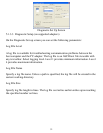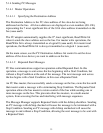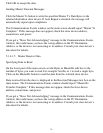33
5.1.4 Sending I
2
C Messages
5.1.4.1 Master Operations
5.1.4.1.1 Specifying the Destination Address
The Destination Address is the I
2
C slave address of the slave device being
addressed on the bus. All slave addresses are displayed as even numbers (00...FE),
representing the 7 most significant bits of the 8-bit slave address transmitted on the
bus (aaaa aaa0).
The I
2
C adapter automatically supplies the 8
th
, least significant, Read/Write bit
when it sends the slave address across the bus. For master write operations, the
Read/Write bit is always transmitted as a logical 0 (aaaa aaa0). For master read
operations, the Read/Write bit is always transmitted as a logical 1 (aaaa aaa1).
On the main screen, use the I
2
C Destination Address list control to set the slave
address of the slave device you want to address on the bus.
5.1.4.1.2 Repeated Start Messages
I
2
C Bus communications support an operation called Repeated Start. In this
operation, a message is sent across the bus beginning with a Start Condition, but
without a Stop Condition at the end of the message. The next message sent across
the bus begins with a Start Condition, in this case a Repeated Start.
An I
2
C Bus master, that successfully sends a message on the bus, owns the bus until
that master sends a message with a terminating Stop Condition. The Repeated Start
operation allows the bus master to retain control of the bus while sending one or
more messages on the bus. This prevents other bus masters, in a multi-master
system, from accessing the bus and interfering with message sequences.
The Message Manager supports Repeated Starts with the doStop checkbox. Sending
an I
2
C message with doStop checked will cause the message to be terminated with a
Stop Condition. Sending an I
2
C message with doStop unchecked will cause the
message to end without a Stop Condition, allowing the next message to be sent with
a Repeated Start.


















